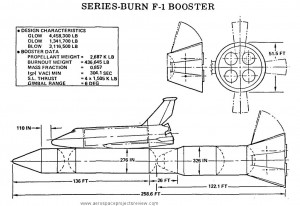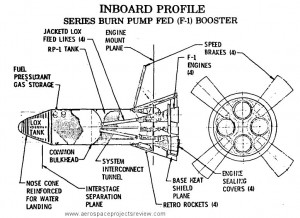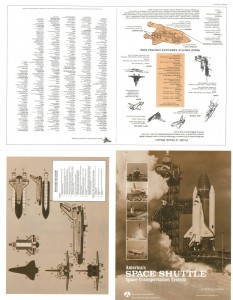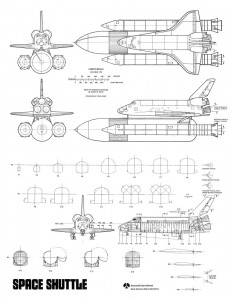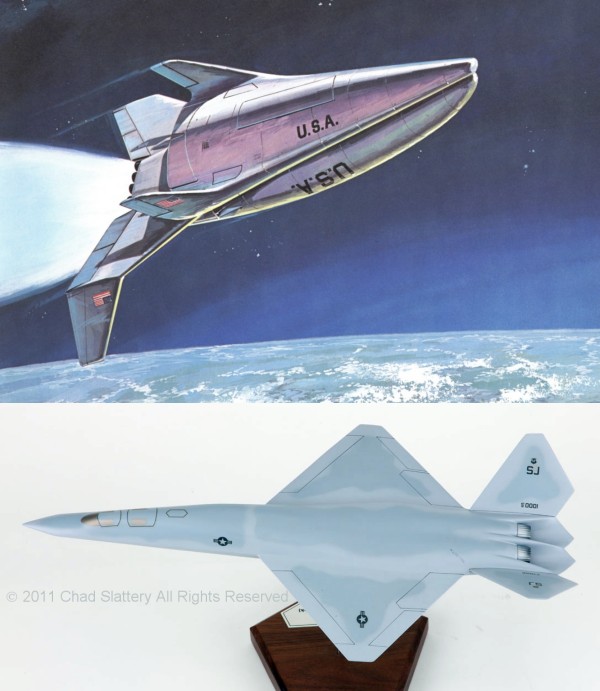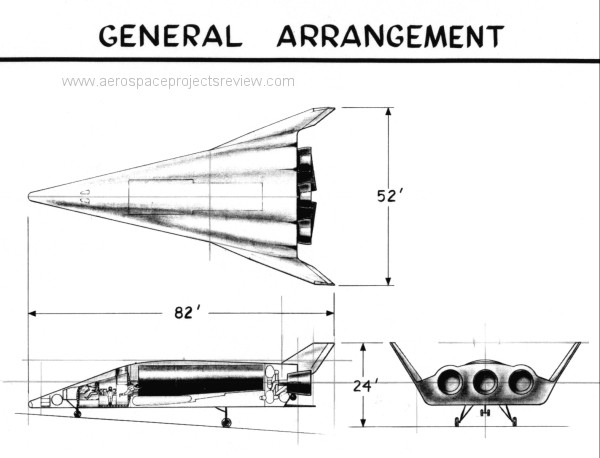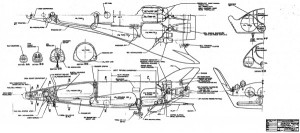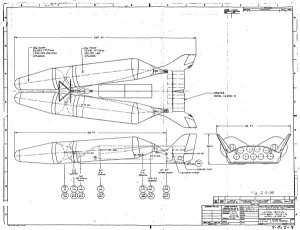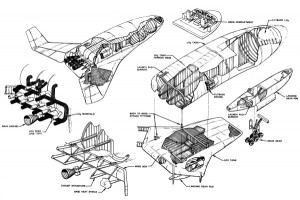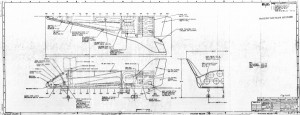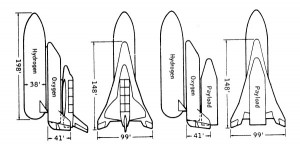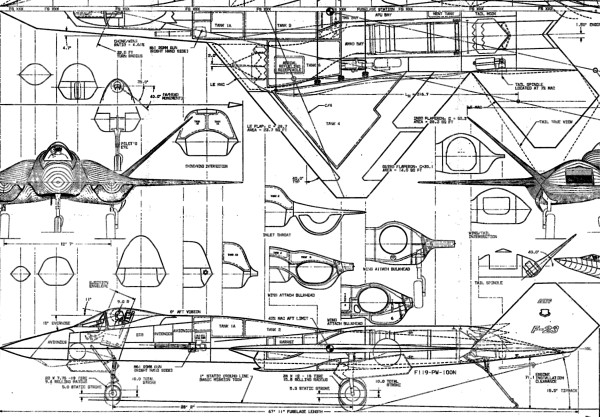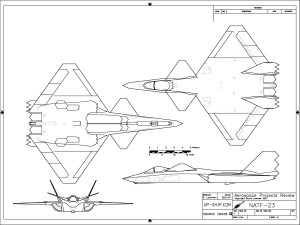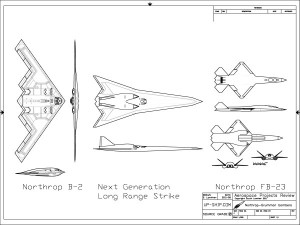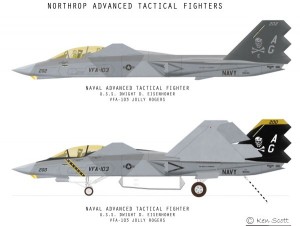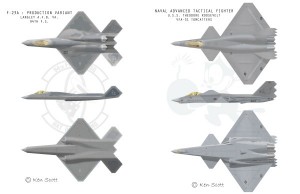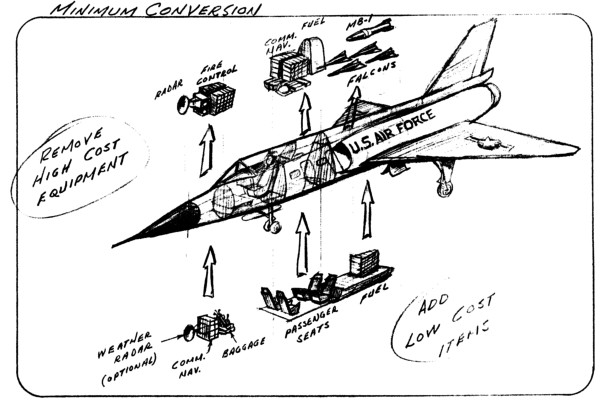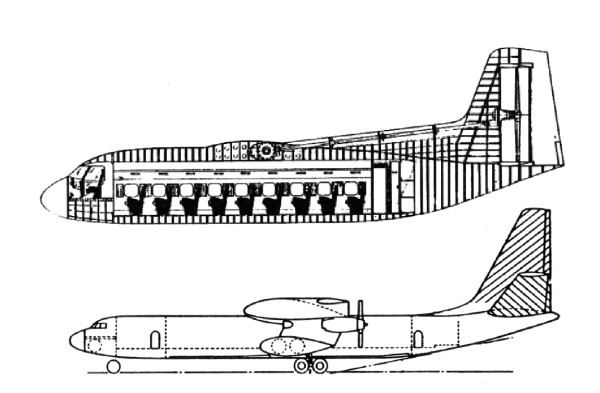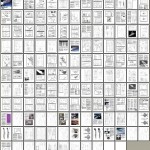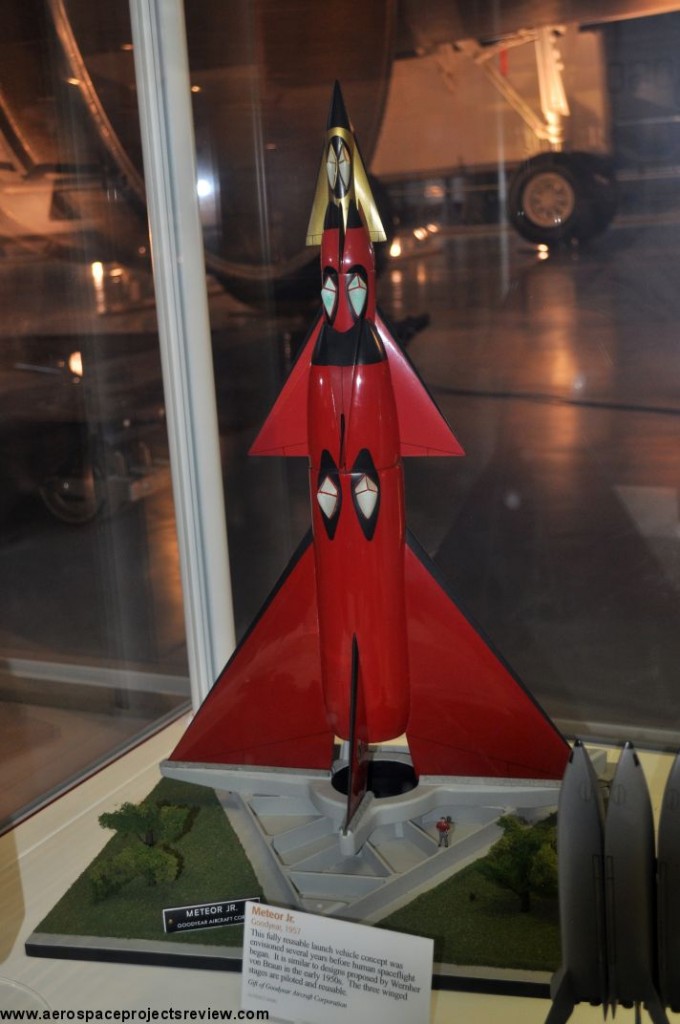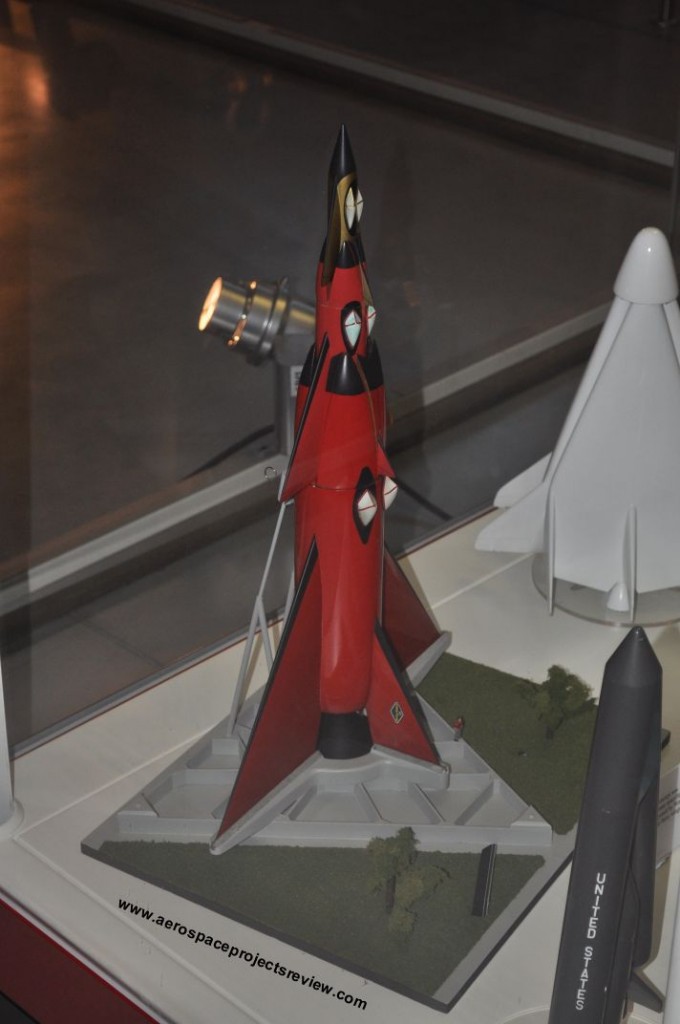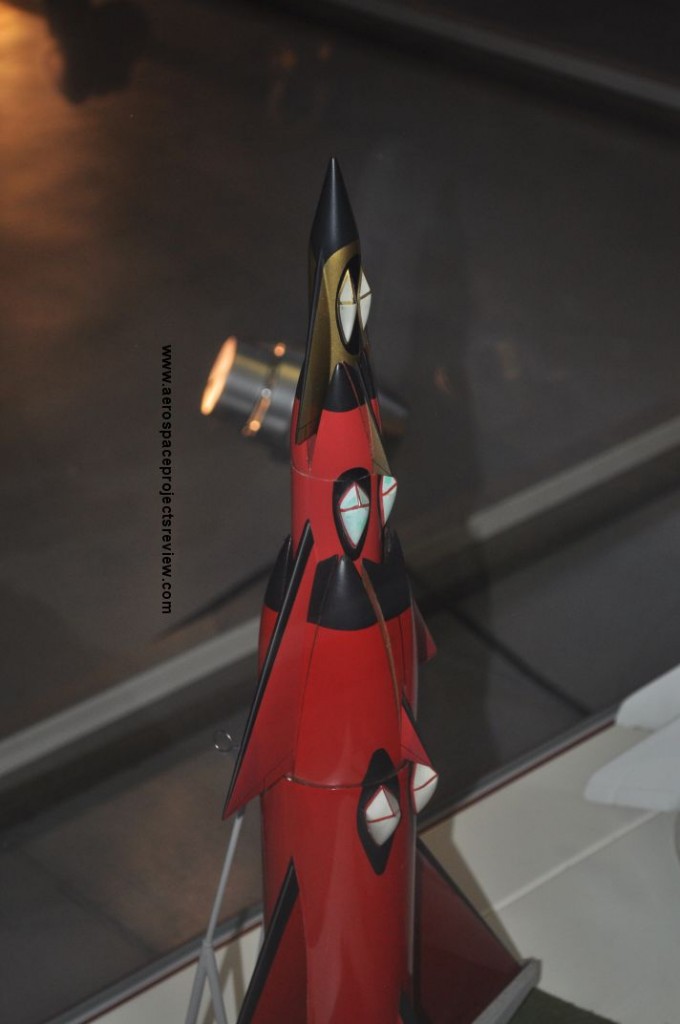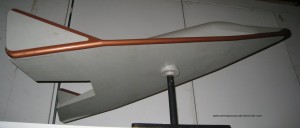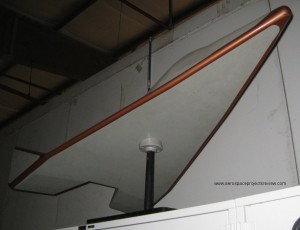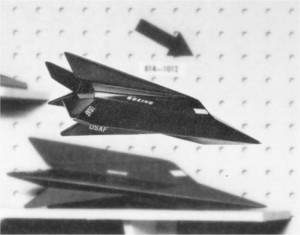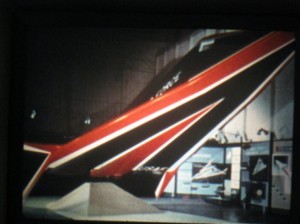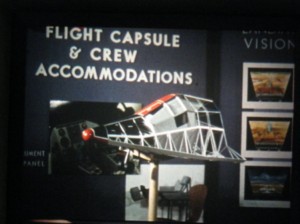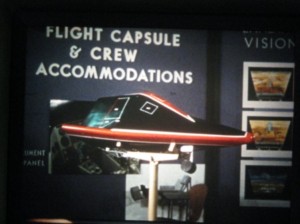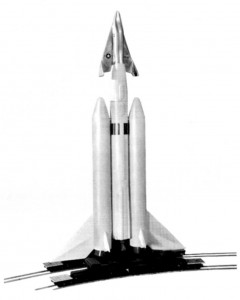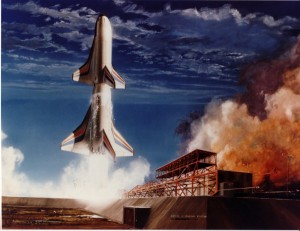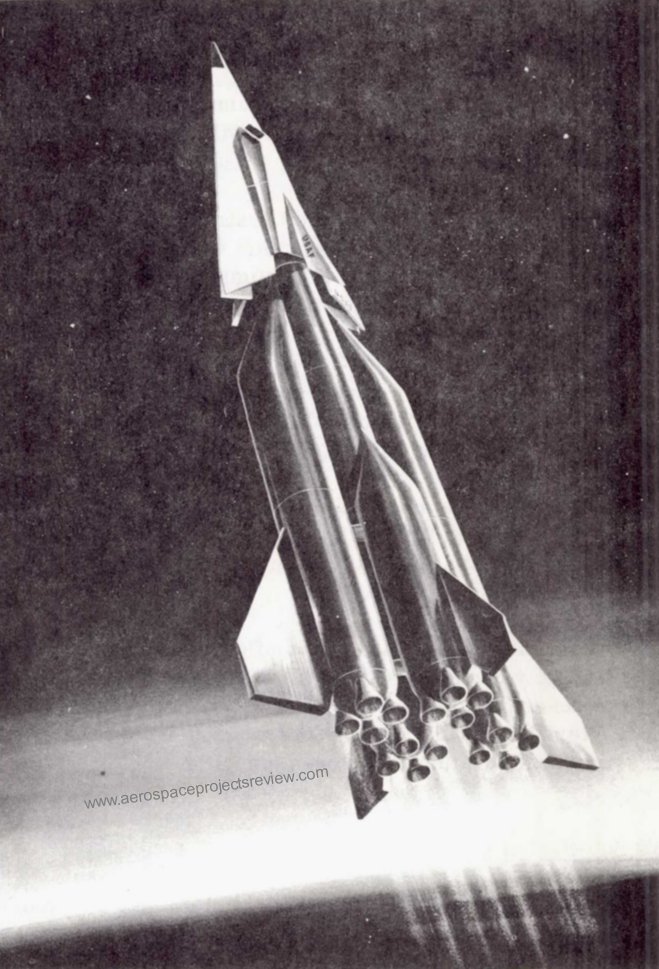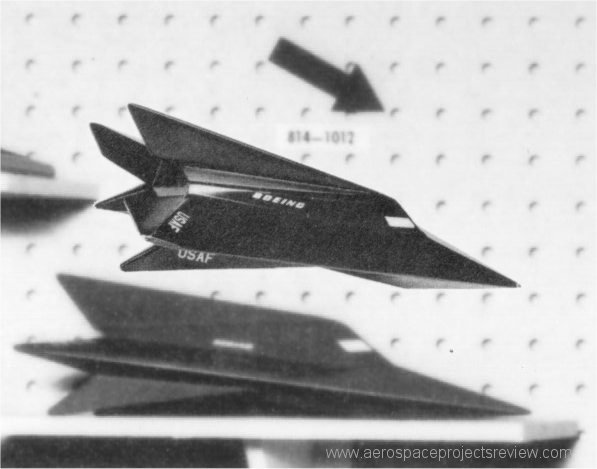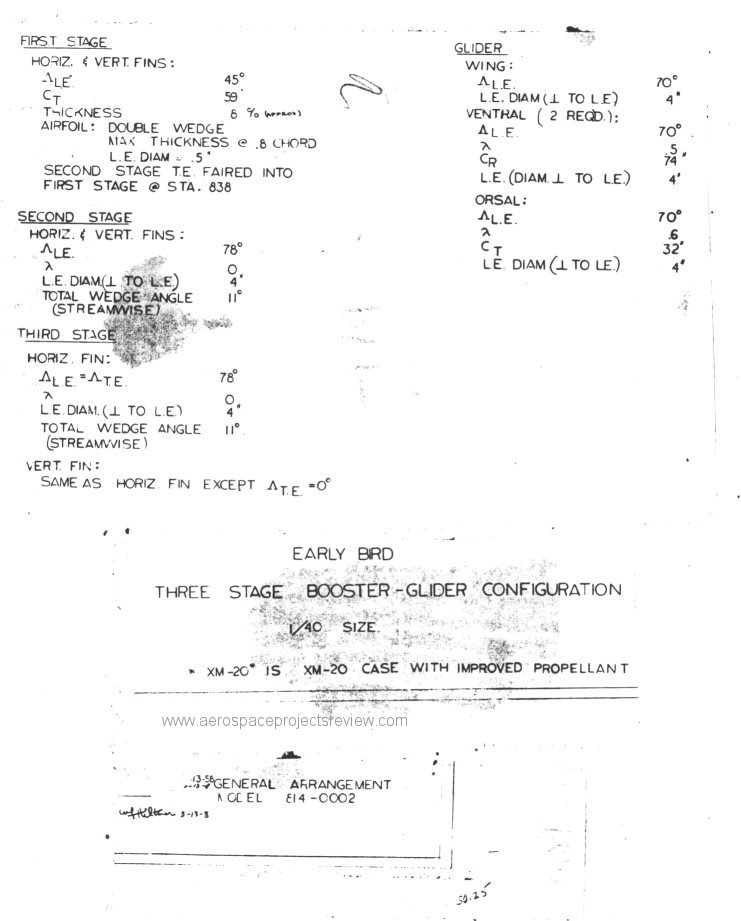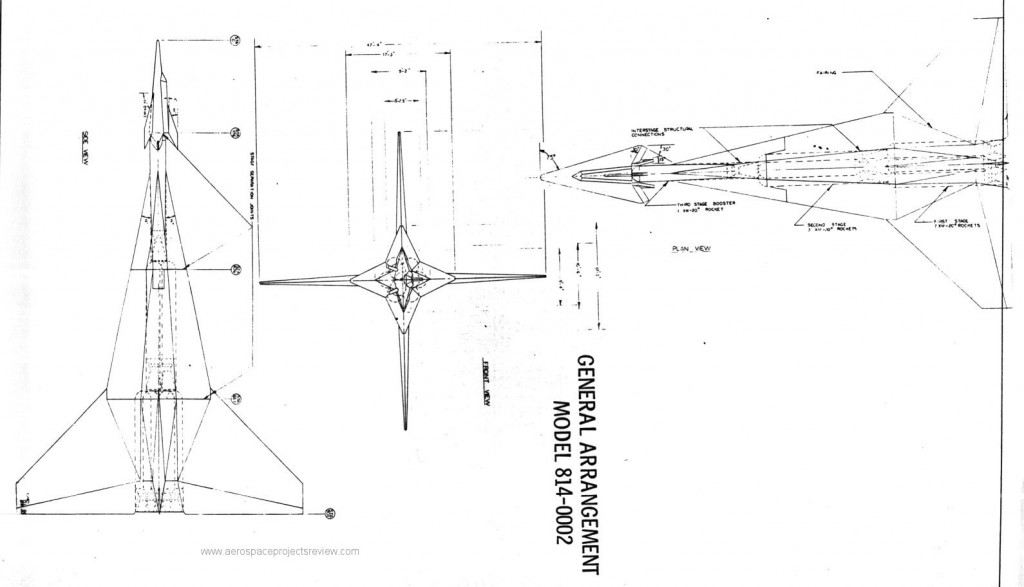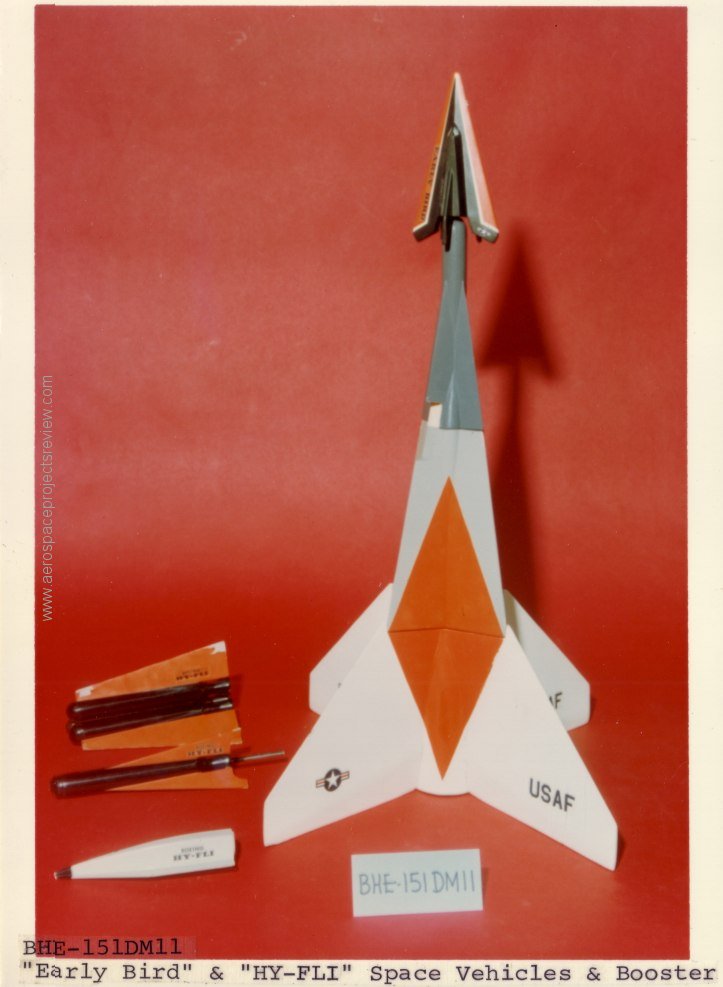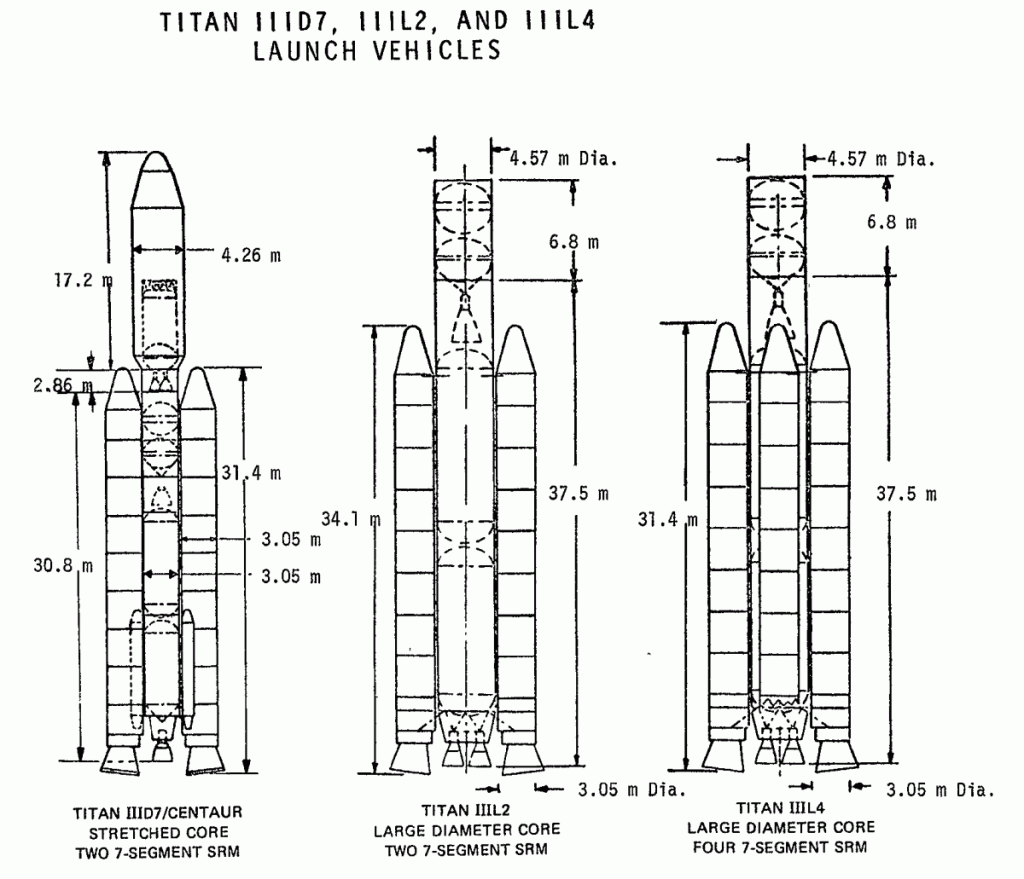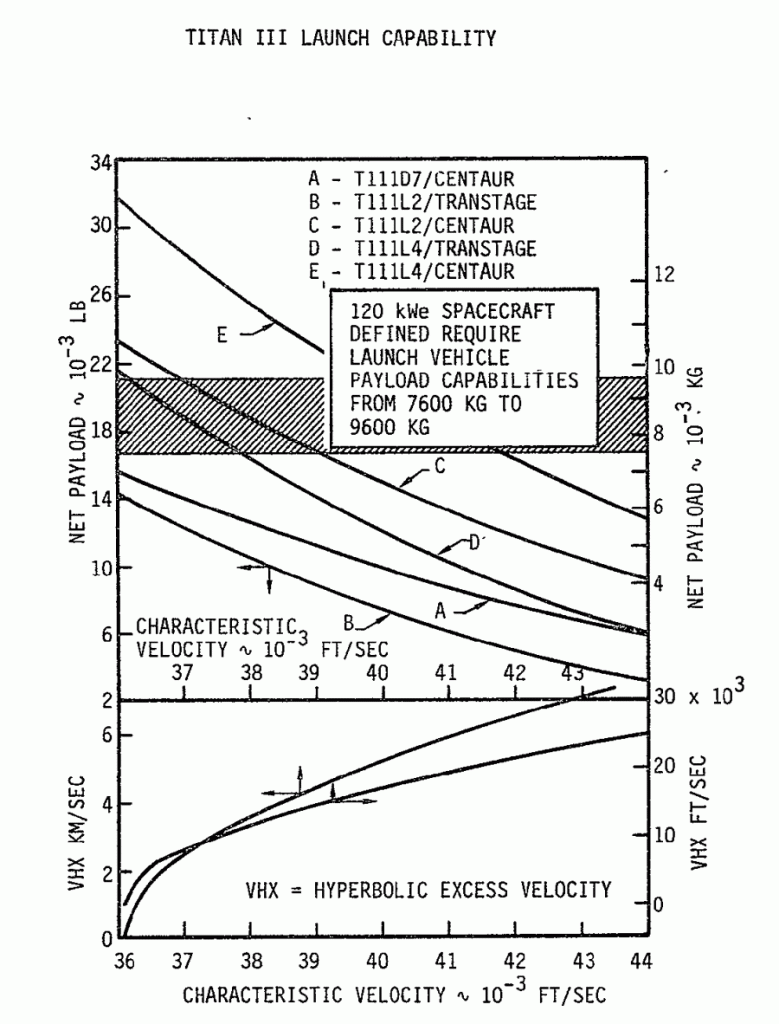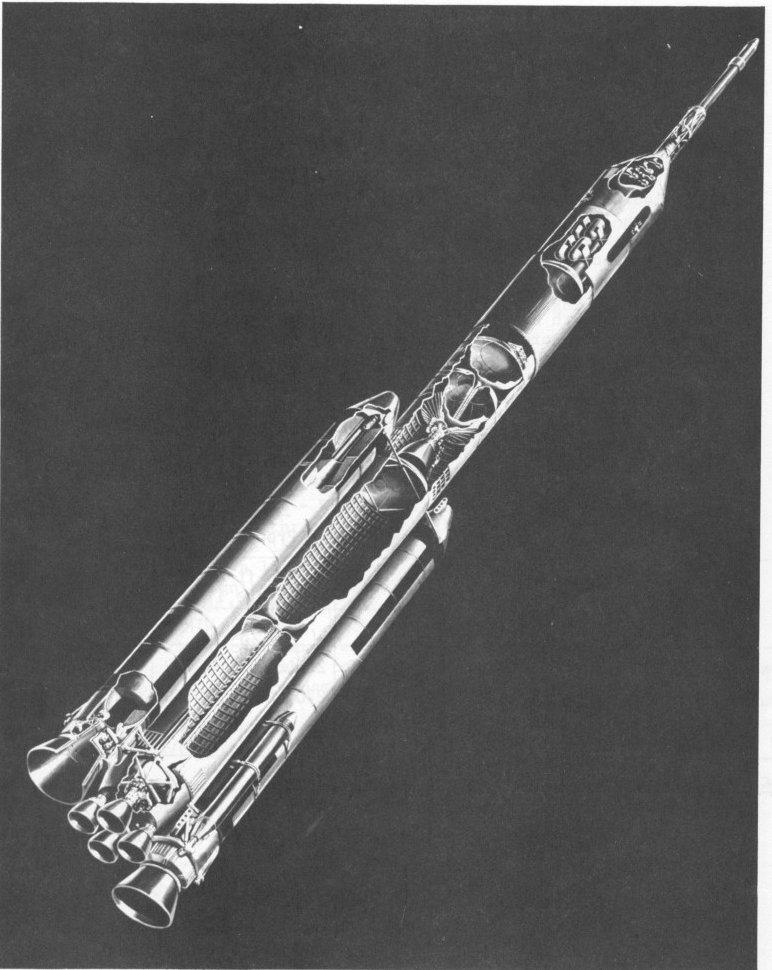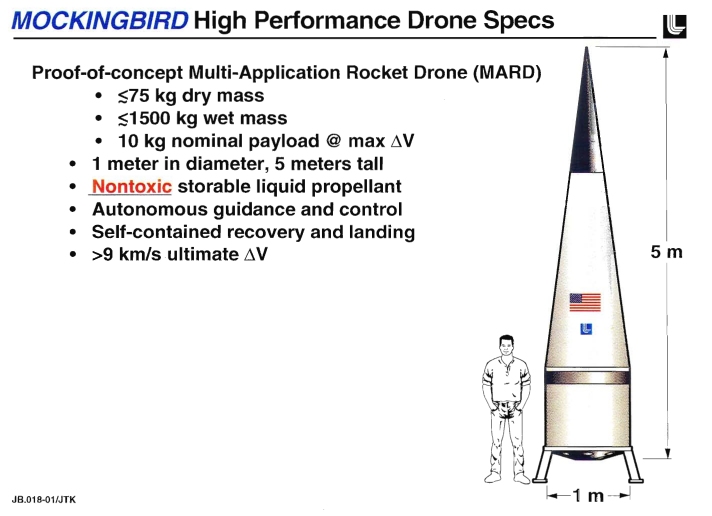An early 1971 design from McDonnell Douglas for the Space Shuttle Phase B extension program. As an alternative to solid rocket boosters, this concept used a single liquid rocket booster underneath the external tank. Several concepts were studied, including pressure fed systems. This particular design used four F-1 rocket engines from the Saturn V, in an entirely new booster. The booster would be recovered at sea, splashing down nose first; large flaps would stabilize it nose-down during descent, and solid rocket motors would provide terminal deceleration.
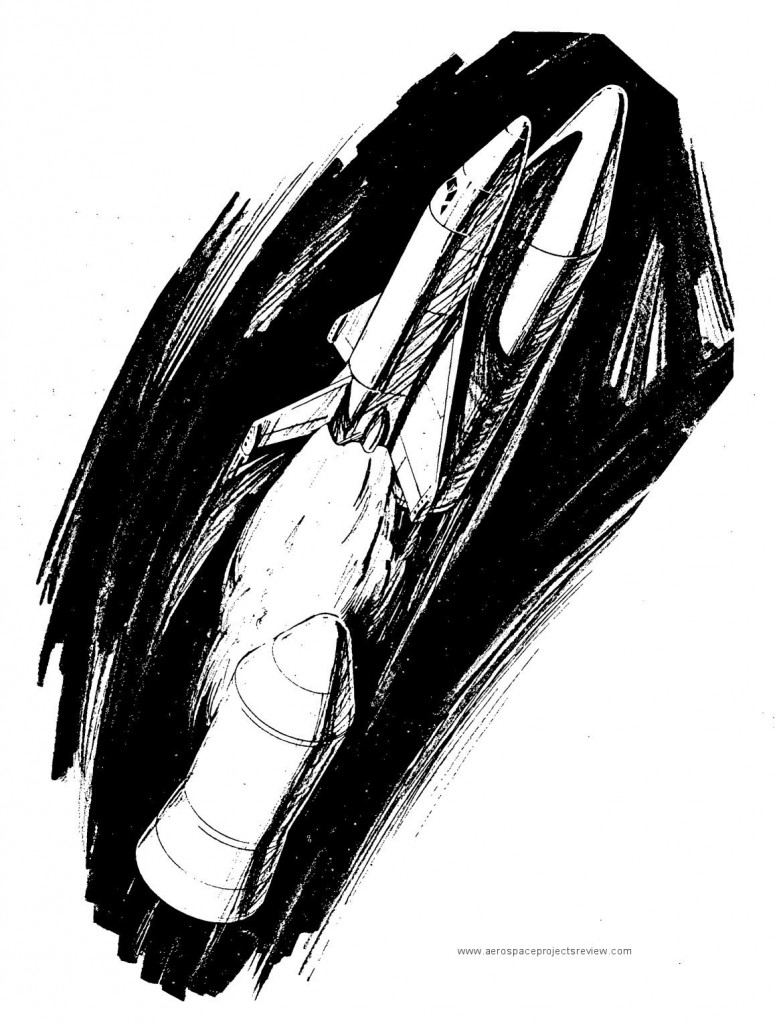
An informational poster from Rockwell International showing the configuration of the Space Shuttle dating from, I believe, February 1983. Provides geometric data as well as coloration, mission profile and subcontractor data.
You can download a 9 megabyte ZIP file with 300 DPI scans of both front and back of this poster. The 1/200 scale drawings are particularly nice. The link to the ZIP file is HERE. To access it, you will need to enter a username and password. The username: the first word in the body of the text on page 8 of APR issue V3N2. The password: the first word in the body of the text on page 24 of the same issue. Note that both are case sensitive.
At long last, Aerospace Projects Review issue V3N2 is now available.
The main article, about 90 pages worth, covers the Lockheed STAR Clipper concept.This was a one-and-a-half stage space shuttle concept. Starting in 1968 for the USAF, the concept lasted well into Phase B of the Space Shuttle program for NASA, and in altered form into the 1990’s. This article has a very large number of detailed schematics of many different forms, including the original small 1.5 Stage To Orbit design, numerous variations on that concept, fully reusable two stage versions with manned boosters, giant concepts for Solar Power Satellite logistics and miniature versions for the USAF in the 1980s.
Also included is an article covering antecedents and derivatives of the Northrop F-23 stealth fighter. Included are early designs such as the “Christmas fighter” and several “platypus” concepts, the F-23A operational fighter design, the NATF-23 concept for the US Navy with aft mounted wings and canards, the single-engined Multi Role Fighter (from the competition that led to the F-35) and perhaps most interestingly, the F/B-23 regional bomber, of eBay infamy. This article is illustrated with a mix of photos of official Northrop display models, official Northrop diagrams, all-new scale diagrams and color artwork especially commissioned for this article.
Dennis R. Jenkins provides an article on a Convair concept for converting the F-106 interceptor into a small supersonic transport. Compare this to Convair idea of converting the B-58 Hustler into an SST!
And finally, two aerospace history “nuggets,” the Vanguard Model 18 VTOL transport and a Northrop laminar flow control multipurpose long-duration aircraft.
You can see the entire issue here:
It is available in three formats. Firstly, it can be downloaded directly from me for the low, low price of $10. Second, it can be purchased as a professionally printed volume through Magcloud; third, it can be procured in both formats. To get the download, simply pay for it here through paypal.
——–
———
To get the printed version (or print + PDF version), visit my MagCloud page:
ALSO AVAILABLE: V3N2 Addendum, with 65 pages formatted for 11X17 sheets. Includes larger format (and higher rez images) along with additional artwork and diagrams that were not in issue V3N2 due to space constraints.
V3N2 Addendum download order: $5.00
———
In 1957, Darrell Romick of Goodyear produced the “Meteor Jr.” design for a three stage fully reusable manned launch vehicle, a smaller version of the “Meteor” design from 1954. The designs were straightforward, with simple but gigantic delta wings.
As with other, similar designs of the period, such as Werner von Brauns “Ferry rocket” and derivatives, the math behind the performance of the Meteor Jr. was sound. However, like those other designs, the physics underlying re-entry would have trashed the Meteor Jr. Thin sharp wings made out of steel simply cannot withstand the aerothermal heating. Additionally, the large bubble canopies would have been at best problematic.
The Air & Space Museum Udvar-Hazy facility has a Goodyear display model of the Meteor Jr. vehicle on display.
A few examples of models and mockups of different versions of the Dyna Soar:
A few years back I got to poke around a little bit in the NASM Garber facility. Lighting was not the best and some areas were photography-discouraged, but there were a few things that I got some photos of. One was a large model of an early Boeing Dyna Soar configuration. It may have originally been a wind tunnel model that was repurposed into a display model, or it may have been a display model from the get-go (kinda big, though).
————–
One of Boeings earliest Dyna Soar designs, the Model 814-1012, dating from about March, 1958. Terribly ’50′s in design, looks like a hood ornament. All angles and fins, including two ventral fins which would have had a hell of a time surviving re-entry. This image is made from two separate kinda blurry photos of presumably the same display model.
———
Mockup and display model photos, circa 1960. Taken from a mockup review film.
———
A photo of a Martin corp. display model showing an early Dyna Soar/Titan III configuration. The Titan III would lose the fins after testing showed that the thrust vectoring capability of the Titan III’s UA-1205 booster rockets was up to the task of countering pitch moments produced by the Dyna Soar.
Parts of this were originally posted HERE, HERE, HERE and HERE.
I have an article on the Boeing Space Freighter in the latest issue (July/August 2011) of “Horizons,” the newsletter of the Houston AIAA chapter. Free to download here:
Boeings initial concept for the Dyna Soar – meant to be an actual orbital bomber – bore almost no relationship to the final X-20 Dyna Soar. All sharp edges and fins like a 57 Cadillac, it wound up looking almost nothing like the Dyna Soar that almost got built. Irritatingly for Bell Aerospace, the final Dyna Soar design looked a *lot* like the Bell entry. The winning Boeing entry was just very, very wrong. The baseline launch vehicle for it, for instance, was a kludged-together monstrosity composed of Minuteman ICBM stages clustered together. Of course, Minuteman had the advantage of being a Boeing product, so there ya go.
Another oddity about the Boeing design is that even though it won, and you can get some pretty detailed drawings and wind tunnel reports and whatnot about many of the competing designs… the Boeing design is rarely depicted with much more detail than a bare three-view. It’s like they phoned it in, not expecting to win… and they won anyway.
The basic design of the initial Model 814 Dyna Soar was tinkered with repeatedly until it eventually turned into the well-known Dyna Soar (as shown in the Aerospace Projects Review Blog header image). One such early configuration is the Model 814-1012 is shown in model form here:
While the initial baseline launch vehicle was proposed to be a cluster of Minuteman stages with sizable fins to maintain aerodynamic stability, alternative designs were of course put forward. One such design is shown in these drawings of the Model 814-0002 launch vehicle + Dyna Soar. This design, from 3-13-1958, features a three-stage booster composed of clusters of XM-20 “Sergeant” rocket motors… seven on the first stage, three on the second, a single rocket on the third… and the biggest damned fins EVAR. Note that the concept is named “Early Bird.” Note that “Early Bird” was also a name for Intelsat 1, the first communications satellite. In the case of the Boeing Model 814-0002, Early Bird likely referred to the supposed ability of a cluster of Sergeant motors to be slapped together and made to fly quickly, sooner than a dedicated launch vehicle.
Portions of this were originally posted HERE, HERE, HERE and HERE.
The Titan IIIL series was a Martin Marietta concept (late 1960’s into early 1970’s) for a heavy lift derivative of the Titan IIIC launch vehicle. The core would be increased in diameter from 10 feet to 15, and the number of liquid propellant rocket engines increased from two to four. Additionally, the vehicle could be given two, four or six solid rocket motors (Titan IIIL2, Titan IIIL4, Titan IIIL6). The Titan IIIL6 concept was considered as a first stage booster for the Space Shuttle.
The Titan IIIL2 had enough lift capacity to launch an Apollo-derived capsule and service module, providing an alternative to the Saturn Ib for space station logistics and crew transfer.
Designed in the early 1990′s at Lawrence Livermore National Labs by Jordin Kare, the “Mockingbird” was a conceptual design of a single stage rocket vehicle. It was to be relatively cheap, as befits a vehicle designed officially to serve as a target. Replicating the trajectory of ballistic missiles, it was to serve as the target for ballistic missile defense systems.
But it was found that, if design properly, the simple target vehicle could do some rather more interesting things than simply get blasted. With a very lightweight aluminum rocket engine (yes, a rocket engine can be made from aluminum – it simply needs good regen cooling and, preferably, some additional fuel-film cooling) burning a combination of hydrogen peroxide and JP-5 performance in terms of thrust and Isp would be fairly high, and bulk vehicle density would also be quite high. It would, in fact, be just barely possible that this modest target vehicle would be able to attain low Earth orbit with a payload of 10 kilograms… hence the nickname “bricklifter.” Empty weight would be 75 kilograms; light enough to be picked up be two men.Gross weight would be 1500 kilograms; light enough to be carried by a largish pickup truck. And small enough that it could potentially be launched from the back of a smallish pickup truck.
Included in that 75 kilograms was re-entry shielding to allow the Mockingbird to survive re-entry, landing gear and enough rocket propellant for a soft touchdown. It was, essentially, a minimum-size Delta Clipper.
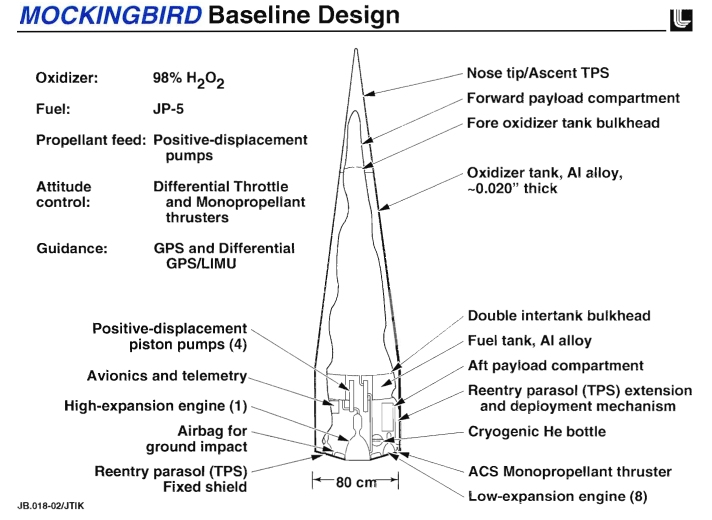 Like just about everything in aerospace, it likely would have come in over budget and over weight. But as the likes of Xcor, Armadillo Aerospace and Masten Space Systems have shown, relatively small groups on shoestring budgets (by government standards) can, with time and effort, develop just the sort of technologies needed to make vehicles like the Mockingbird work. And if one of these companies can actually build a SSTO on the scale of the Mockingbird… boy howdy, the Air Force should be *desperately* interested. Sadly, so will the regulatory agencies. But private citizens building orbital vehicles they can launch from their trucks? Awesome.
Like just about everything in aerospace, it likely would have come in over budget and over weight. But as the likes of Xcor, Armadillo Aerospace and Masten Space Systems have shown, relatively small groups on shoestring budgets (by government standards) can, with time and effort, develop just the sort of technologies needed to make vehicles like the Mockingbird work. And if one of these companies can actually build a SSTO on the scale of the Mockingbird… boy howdy, the Air Force should be *desperately* interested. Sadly, so will the regulatory agencies. But private citizens building orbital vehicles they can launch from their trucks? Awesome.
This was originally posted HERE.
ATK artwork showing the Boeing/ATK “AirLaunch” concept from a few years back. Started around 1999, petered out a few years later. It called for a winged solid rocket booster similar in outlines to the OSC Pegasus, but larger and carried on the back of a 747. Upon release, the 747 would be obliged to dive out of the way, lest the rather dense booster bonk back into it. As shown below it is equipped with a Space Maneuver Vehicle for payload… a slightly earlier iteration of the X-37 spaceplane. The first two stages would have been Castor 120′s (Peacekeeper first stages, also the Athena booster), while the third would be a new design. Total payload was to have been about 7,500 pounds.
